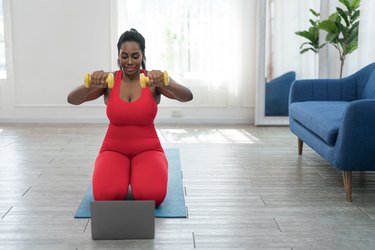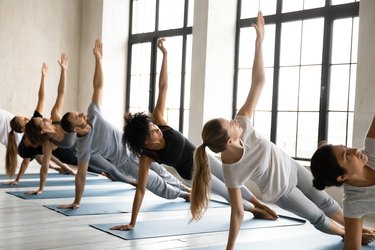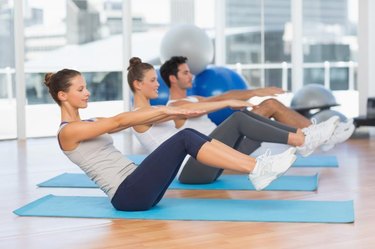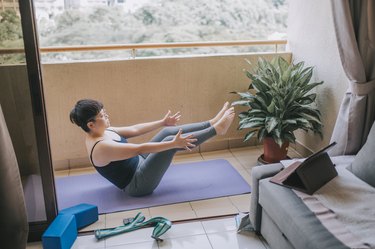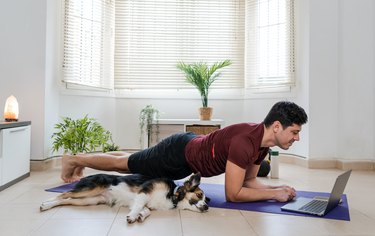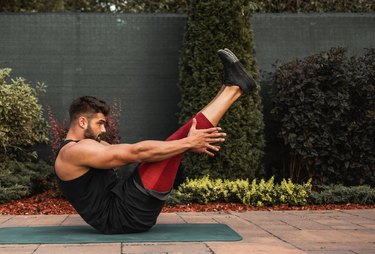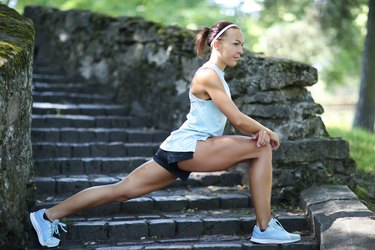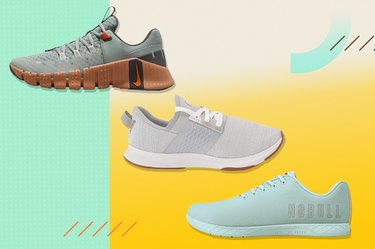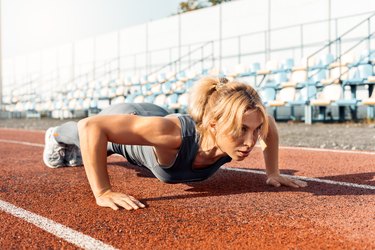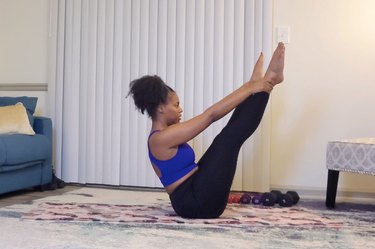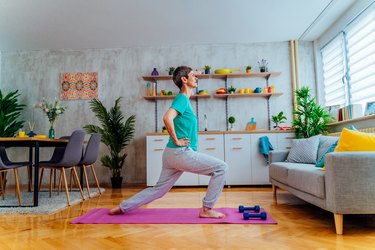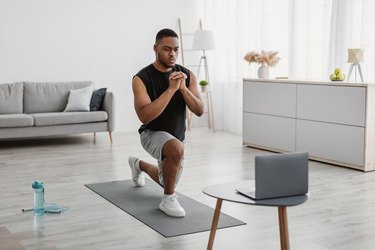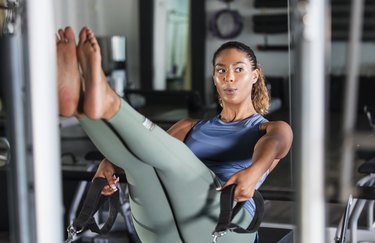
Pilates has gained a reputation for being the go-to workout (or "system of exercise," depending on who you're talking to) for ballet dancers, celebrities and people who dream of a core of steel and impeccable posture.
But as the experts and research will tell you, Pilates is so much more. It's now more accessible than ever, thanks to free, high-quality instruction and no-equipment Pilates workouts available online, including wall pilates.
Video of the Day
Video of the Day
There are also multiple types of Pilates if you like one modality more than others. People of all ages, genders, backgrounds, degrees of experience and levels of fitness can participate in the practice, and Pilates benefits extend far beyond the aesthetic.
If you've always wondered what Pilates is good for, below are 13 ways it can improve your health, fitness and quality of life.
1. Pilates Builds Deep Core Strength and Stability
If you know just one Pilates benefit, it's that it's a killer core workout that (literally) goes deeper than typical ab exercises. (And if you've ever been sore after Pilates, you know how much focus is on the core.)
"Pilates takes a holistic approach to the core," Nicole Pearce, STOTT-certified Pilates Instructor and creator of Nicole Pearce Movement on YouTube, tells LIVESTRONG.com. "There are lots of effective ways to target the outer layers of abdominals, but where Pilates really stands out is in its particular attention to diaphragmatic breathwork and the deep core, [which includes] the transverse abdominis and pelvic floor."
A December 2021 study in the International Journal of Environmental Research and Public Health measured the core muscle activity in Pilates-trained participants and individuals without any Pilates experience. The Pilates-trained group had better pelvis stability and could more effectively activate their core muscles.
2. It Increases Flexibility and Range of Motion
Lexi Harrington, Balanced Body-certified Pilates instructor and lead trainer at SLT, explains that Pilates form and movements like lunges, overhead reaches and leg circles can help increase flexibility and improve your joints' range of motion.
Flexibility, she explains, supports a better quality of movement in everyday activities. Simple actions, like reaching to grab something from a high shelf or bending down to tie your shoes, can be difficult without a moderate amount of flexibility.
Flexibility can also safeguard you against injuries. "Let's say you're walking, and you roll your ankle," she says. "If you don't have flexibility and mobility there, a small roll might pull something quicker or easier. But if you have a little bit better range of motion and flexibility and the muscle strength around [the ankle] to support it, that could help prevent that injury."
3. Pilates Workouts Reinforce Good Posture
"One of the benefits I see immediately when working with my clients is postural," Troy McCarty, Balanced Body master teacher who trained under the original students Joseph Pilates, says. "I immediately see them starting to sit up straight. They're putting balance in the muscles that are unbalanced, which [can] create headaches, shoulder pain, back pain," he says.
Harrington explains that these postural improvements stem from newfound flexibility and strength in the core and back. "Pilates helps keep the front of your chest open by strengthening all the muscles on your back," she says. "Without core strength, our shoulders start to fall forward."
4. It May Alleviate Back Pain
While Pearce, McCarty and Harrington each have stories of clients who noticed an improvement in their back pain after learning how to do Pilates, there's also scientific evidence to back up those anecdotes.
A small July 2021 study in the Journal of Bodywork and Movement Therapies found that individuals with chronic nonspecific low back pain (CNLBP) who participated in a supervised Pilates-based core exercise program for eight weeks achieved a better quality-of-life score than those with comparable back pain who did not do Pilates.
A January 2019 study from the Postgraduate Medical Journal that looked at current research and systematic reviews on CNLBP determined that Pilates was effective at reducing pain and improving functional outcomes.
5. Pilates Strengthens the Pelvic Floor
Because Pilates taps into the deep core and pelvic floor muscles, it may help address symptoms related to pelvic floor weakness and dysfunction.
A February 2020 study published in the Journal of Alternative and Complementary Medicine recruited women experiencing stress urinary incontinence (SUI), or peeing involuntarily when intra-abdominal pressure suddenly increases. (If you've ever leaked a little when coughing, sneezing, laughing or jumping rope, you're familiar with the issue.)
The experimental group participated in a 12-week Pilates program while the control group resumed normal activities. In their six-month follow-up, researchers found that the women who did Pilates experienced decreased incontinence.
Research on Pilates and the pelvic floor is still relatively new, and more research is needed on both topics, particularly with a more diverse population (most Pilates studies, like the one above, classify participants as women). But the benefits extend to everyone, as everyone as a pelvic floor — not just people with vaginas.
6. It Can Heat Up Your Sex Life
Another upside to having a strong pelvic floor: better sex. "A strong pelvic floor does correlate with increased sexual pleasure — people forget about that one," Harrington says, referring to a January 2021 study in Investigative and Clinical Urology that looked at pelvic floor muscle strength in people with vaginas.
Also, increased flexibility and overall strength and conditioning can mean more stamina and range of motion between the sheets. "I was teaching a group class, and I had this one lady, I would say she's probably early sixties," McCarty recounts. "And she goes, 'I just want everybody to know that I can do things in bed that I was doing when I was 40. I never thought I could do it again!'"
7. It Relieves Stress and Anxiety
The mental health benefits of Pilates are often the most surprising to clients who began practicing with goals related to physical strength and conditioning, says Pearce. An April 2018 meta-analysis in Complementary Therapies in Medicine found that Pilates helps with mental health outcomes.
"The diaphragmatic breathing used in Pilates can help reduce stress and anxiety," she explains. "The vagus nerve balances our sympathetic and parasympathetic nervous systems. The sympathetic nervous system is associated with fight or flight (think increases in cortisol and other stress hormones). The parasympathetic, on the other hand, is associated with rest and digestion. The diaphragm actually stimulates that oh-so-important vagus nerve. So deep diaphragmatic breathing helps with relaxation and stress reduction."
8. It's Excellent Cross-Training
Pearce likes to think of Pilates as "cross-training for life."
"Pilates is a very foundational practice — you can think of it as laying strong groundwork [for] deep core, breathing, happy hip joints, stable shoulder joints — upon which you can then build with whatever your favorite type of movement or workout is," she says.
"I see so many people notice injury and pain reduction because they're strengthening their base. Many report feeling more supported and strong when moving throughout their day and doing the activities they love, whether that's dancing, skiing, weight lifting, running, whatever."
In addition to aiding injury prevention, Pilates may also improve your overall athletic performance. A small March 208 study in PLOS One found that runners who did Pilates for 12 weeks improved their 5K run times.
Researchers hypothesize that better control and stabilization of the pelvis allows runners to "minimize their metabolic cost." In other words, running 3.1 miles is much less taxing on your body when you have a strong core.
9. Pilates Bolsters Bone Density
Because Pilates includes weight-bearing exercises, it can help prevent osteopenia and osteoporosis by boosting bone density, which decreases with age, Harrington explains. "It's great to start Pilates when you're younger before any of that starts to happen," she says.
However, research shows that older adults already experiencing bone loss can also benefit. One small September 2015 study in the Journal of Back and Musculoskeletal Rehabilitation involving postmenopausal people with osteoporosis found that, after 24 weeks of three 60-minute Pilates workouts a week, participants experienced significant increases in bone mineral density. They also felt less pain when at rest and while moving.
10. It's an Excellent Option for Rehab
If you happen to find yourself sidelined with an injury, Pilates can help you recover, rebuild and get back in the game.
"You can kind of control that weight that you're working with, and it's a lot of really small movements that target a lot of those stabilizing muscles," Harrington, who often works with injured athletes and ballet dancers, says. "So it's not just your main movers. It's the smaller muscles that are so important to help support your joints," she says.
Harrington is also a fan of using the Pilates reformer, an apparatus that uses spring resistance and a moving mat, as a rehab tool. "The springs and the machine can either assist you, or they can challenge you. So if you're dealing with an injury, sometimes you might need those springs to assist you," she says. (Read more about Pilates reformer-specific benefits here.)
11. It's Low-Impact (But Still Challenging)
For people who have joint issues, nagging injuries, or just prefer not to run or jump when exercising, Pilates offers a low-impact workout that's still plenty challenging, even for more advanced practitioners and physically fit beginners.
"So many first timers will come in, and at the end of class their first class say, 'Wow, that was humbling,'" Harrington says. Even for those who exercise regularly, Pilates taps into something different by slowing down movements and focusing on the connection between the body and the mind, she explains. "I think that when movements are done really, really fast, it's easy to just think about something else. And you lose that mind-muscle connection," she says.
She uses the hip bridge exercise as an example, noting that most people can mindlessly speed through a hundred hip bridges without feeling much.
"But if you actually do it right and you think about what should be initiating the movement — glutes to hamstrings — and you find that muscle engagement at the top and hold for a second before releasing down, you could do 10 reps and really [feel it] in back of your legs, in a good way because it's working. It's active," she says.
12. It's a Great (and Safe) Workout If You’re Pregnant or Postpartum
For so many of the reasons above, Pilates is a great exercise option for pregnant people. It's low-impact, reduces anxiety and can help alleviate back pain, which is common during pregnancy. One small January 2021 study in the Journal of Back and Musculoskeletal Rehabilitation found that pregnant people who did Pilates twice a week for eight weeks experienced significant improvements in their back pain, mobility and sleep.
And if you're recently (or not so recently) postpartum, Pilates can help address postural issues, reconnect your breathing to your core functionality and strengthen your pelvic floor, typically stressed by months of carrying the weight of a growing baby, labor and birth. (Of course, get your doctor's OK before starting any pregnancy or postpartum fitness program.)
13. Pilates Makes Aging Enjoyable
Want to age well? Start doing Pilates. McCarty primarily works with older adults, including people in their eighties and nineties who are trying Pilates for the first time. They come to him after years of being sedentary and accumulating the aches and pains of aging.
But because Pilates is low-impact and can easily be modified to all levels of experience and physical ability, this older population thrives.
"Many of them say 'I'm able to do things I haven't done in a long time,'" McCarty says. "Their range of movement improves. Their vitality improves, they get a little bit more confidence in their movement and spinal flexibility. They're just moving their bodies in a much more intelligent way … I think Pilates helps them rediscover their movement and put it into their daily activities."
